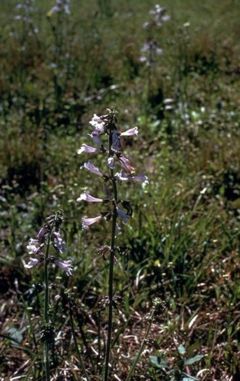Salvia lyrata
| Standard Cyclopedia of Horticulture |
|---|
|
Salvia lyrata, Linn. Hardy perennial with a thickened root: sts. herbaceous, erect, 8-24 in. high, subsimple, pilose: radical lvs. 2-3 in. long, lyrate, erose-dentate, both surfaces hispidulous; cauline lvs. few, oblong-lanceolate, the base long-narrowed; floral lvs. oblong-linear: racemes subsimple, interrupted; floral whorls 6-fld., lax, distant; calyx tubular-campanulate, nodding, pilose; corolla blue-purple, about 1 in. long. May and June. Conn. to Ill., south to Fla. and Texas.— Not frequent in cult.
|
| Salvia lyrata {{{status}}} Fossil range: {{{fossil_range}}}
| ||||||||||||||||||||||||||||||||||||||||||||||||||||||||||||||||||
|---|---|---|---|---|---|---|---|---|---|---|---|---|---|---|---|---|---|---|---|---|---|---|---|---|---|---|---|---|---|---|---|---|---|---|---|---|---|---|---|---|---|---|---|---|---|---|---|---|---|---|---|---|---|---|---|---|---|---|---|---|---|---|---|---|---|---|
 | ||||||||||||||||||||||||||||||||||||||||||||||||||||||||||||||||||
| Plant Info | ||||||||||||||||||||||||||||||||||||||||||||||||||||||||||||||||||
| ||||||||||||||||||||||||||||||||||||||||||||||||||||||||||||||||||
| Scientific classification | ||||||||||||||||||||||||||||||||||||||||||||||||||||||||||||||||||
| ||||||||||||||||||||||||||||||||||||||||||||||||||||||||||||||||||
| [[{{{diversity_link}}}|Diversity]] | ||||||||||||||||||||||||||||||||||||||||||||||||||||||||||||||||||
| {{{diversity}}} | ||||||||||||||||||||||||||||||||||||||||||||||||||||||||||||||||||
| Binomial name | ||||||||||||||||||||||||||||||||||||||||||||||||||||||||||||||||||
| Salvia lyrata L. | ||||||||||||||||||||||||||||||||||||||||||||||||||||||||||||||||||
| Trinomial name | ||||||||||||||||||||||||||||||||||||||||||||||||||||||||||||||||||
| {{{trinomial}}} | ||||||||||||||||||||||||||||||||||||||||||||||||||||||||||||||||||
| Type Species | ||||||||||||||||||||||||||||||||||||||||||||||||||||||||||||||||||
| {{{type_species}}} | ||||||||||||||||||||||||||||||||||||||||||||||||||||||||||||||||||
| {{{subdivision_ranks}}} | ||||||||||||||||||||||||||||||||||||||||||||||||||||||||||||||||||
| [[Image:{{{range_map}}}|{{{range_map_width}}}|]] | ||||||||||||||||||||||||||||||||||||||||||||||||||||||||||||||||||
| Synonyms | ||||||||||||||||||||||||||||||||||||||||||||||||||||||||||||||||||
| {{{synonyms}}} |
Salvia lyrata (Lyre-leafed Sage), is a species of sage native to the eastern United States, from Connecticut west to Kansas, and south to Florida and Texas.
It is a herbaceous perennial plant with low growing leaves and flowering stems growing to 50 cm tall. The leaves are arranged in a basal rosette of large leaves, and smaller leaves in opposite pairs on the erect flowering stem. The basal leaves are up to 15 cm long and 5 cm broad, with several lobes, some approximating to the shape of a lyre, from which the species is named. The flowers are pale blue, up to 25 mm long. The species is often a lawn weed that self seeds into lawns and is tolerant of being mowed.
Cultivation and uses
It is sometimes grown in gardens for its attractive foliage and flowers. Several cultivars have been developed with purple leaves. Two readily available seed raised cultivars include:
- 'Purple Prince' - Grows about 35 cm tall with reddish purple colored veins and dark purple spikes with small lilac colored flowers in dark purple calyces.
- 'Purple Volcano' - Grows about 35 cm tall with dark purple leaves that have a shiny sheen to them. The flowers are light blue in color.